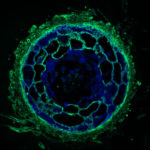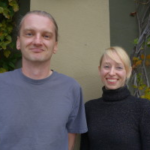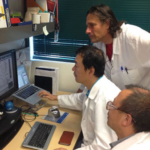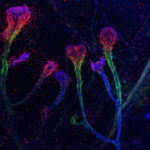The Biosciences Area is pleased to announce that Adam Deutschbauer and Diane Dickel have agreed to take on new leadership positions in the Environmental Genomics & Systems Biology (EGSB) Division. Deutschbauer, previously the department head of Functional Genomics, is rising to the position of EGSB co-deputy for science, and Dickel will assume the role of … Read more »
How Fungi Help Trees Tolerate Drought
The mutualistic relationship between tree roots and ectomycorrhizal (ECM) fungi has been shaping forest ecosystems since their inception. ECM fungi are key players supporting the growth, health and stress tolerance of forest trees globally, and help boost the productivity of bioenergy feedstock trees. To learn more about what characteristics are dominant in the most common ECM fungus Cenococcum geophilum, a team including researchers at the DOE Joint Genome Institute (JGI) compared its genome with the genomes of two close relatives, neither of which are ECM fungi. They found specific adaptations in the Cenococcum genome that could help their hosts be more resistant to drought stress, a finding that could be useful in developing more plant feedstocks for bioenergy amidst the changing climate. The study was published date September 2 in Nature Communications. Read more at JGI News.
Lab-Developed Beamline Tool Launched by Licensee
Based on a beamstop technology licensed from Berkeley Lab earlier this year, MiTeGen LLC has launched the Sentinel™ Real-time Intensity Monitoring Beamstop System for X-ray beamlines. The device improves data collection from X-ray scattering experiments conducted by researchers seeking potential treatments for cancer, AIDS, Ebola, and other diseases.
The Compact Dynamic Beamstop technology developed by Diane Bryant and Simon Morton (pictured) at the Berkeley Center for Structural Biology and licensed by MiTeGen was named a finalist in the 2016 R&D 100 Awards earlier this month, along with six other Berkeley Lab technologies and one multi-lab collaborative effort. Recently, the developers and MiTeGen staff presented the device at the 2016 American Crystallographic Association meeting in Denver.
Study Finds Potential New Biomarker for Cancer Patient Prognosis
A new study, led by Gary Karpen of the Biological Systems & Engineering (BSE) Division, links the overexpression of 14 genes related to cell division to cancer patients’ prognosis and response to specific treatments. The researchers said the findings, published today in the journal Nature Communications, could lead to a new biomarker for the early stages of tumor development. The information obtained could help reduce the use of cancer treatments that have a low probability of helping.
The research team included lead author Weiguo Zhang and Jian-Hua Mao of BSE; collaborators Wei zhu and Anshu Jain; and Ke Liu and James (Ben) Brown of the Environmental Genomics & Systems Biology Division. Read more on the Berkeley Lab News Center.
Outside In: The Secret Life of Galectin-1 and its Dual Role in the Breast
Whenever sugars are mentioned in relation to health and disease, it is in the context of metabolism and gaining calories. However, sugars have many other functions in our physiology and are found on cell surfaces and in extracellular matrix (ECM), forming an integral part of tissue microenvironment. Here they bind to their partner ligands, known as lectins, forming lectin-sugar interactions that have been known to play important roles in physiological and pathological contexts. In an article published and featured on the cover of Proceedings of the National Academy of Science (PNAS) last week, the laboratory of Distinguished Scientist Mina Bissell in the Biological Systems and Engineering Division of Lawrence Berkeley National Laboratory (Berkeley Lab), in collaboration with the research group of Professor Carolyn Bertozzi, now at the Stanford University Department of Chemistry, report exciting data and new insights into the roles a lectin, Galectin-1 (Gal-1), plays in mammary gland branching morphogenesis. This work also sheds some light on breast cancer progression.
- « Previous Page
- 1
- …
- 175
- 176
- 177
- 178
- 179
- …
- 213
- Next Page »
Was this page useful?








